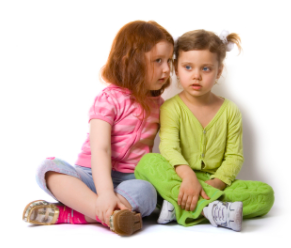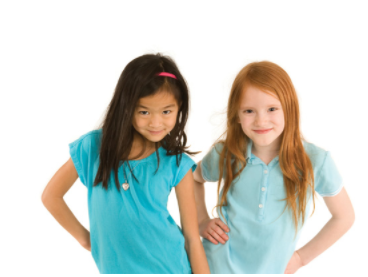ASW
|
 When my daughter entered fourth grade, the classroom dynamics got off to a bumpy start. A few strong personalities — and a new girl jockeying to fit in — led to small conflicts that lasted all year long. In May, the principal called to tell me my daughter and a few other girls were at risk of suspension for that day’s recess if they didn’t clean up their act. Apparently two small groups had volleyed glares that felt intimidating to younger children. It was the proverbial straw. When my daughter arrived home, I said, “Sounds like school was a little rough today.” She burst into tears. She had never been in trouble at school. Most parents associate girl conflicts — and mean-girl tactics — with the middle school years. But conduct known as “relational aggression” (what we think of as “mean girls” behavior) starts much younger. This is the behavior we see when kids manipulate others through friendship withdrawal, silent treatment and gossip. A 2010 study from the State University of New York at Buffalo of children ages 3–12 found that some girls understand relationally aggressive tactics as early as preschool. It also reports that girls associate these tactics with being a girl. In other words, they expect to handle conflict with relational aggression — while boys associate physical aggression with being male. Around second grade, this kind of behavior becomes more sophisticated, and teachers begin to see it in the classroom. “If a girl doesn’t color as neatly, wear the right clothes or can’t do something as well, a second-grader is just as likely to notice as a fifth-grader or a middle schooler,” says Dawn Christiana, a Bellingham elementary teacher. Also beginning in second grade, girls interact more than the younger girls, she says, and become more vocal. “Thus begin the cliques,” says Christiana. What’s normal?Social conflict in elementary school is not new. In fact, conflict among classmates and friends is a normal part of childhood, and parents shouldn’t fear it, says Cubba Reese, a parent educator in the greater Seattle area. What is new? The social pressures girls face today. Roni Cohen-Sandler, Ph.D., author of Easing Their Stress: Helping our Girls Thrive in the Age of Pressure and a longtime psychologist, sees social behaviors in elementary-age girls that used to begin in middle school. Both biology and evolving cultural patterns are contributing to these changes, she says, through earlier physical maturity, exposure to media that portrays relational aggression, more marketing to younger girls and more pressure to achieve academically. As a result, she says, young girls are increasingly anxious, self conscious and competitive. Combine these pressures with the cultural message to girls to play nice (that is, avoid “challenging” emotions such as anger, resentment or jealousy), and social competition among elementary-age girls looks adolescent. JoAnn Deak, Ph.D., author of Girls Will Be Girls, suggests teaching social conflict management skills at younger ages. By middle school, says Deak, the social patterns are habits, and habits are difficult to change. Managing pressuresSo how do we help our daughters manage social pressures and conflict? It starts with building strong connections at home, say experts. Here are some ideas for ways parents can help their girls navigate the new school year: Empathize. If your daughter comes home fuming about a situation, the first step is to empathize — listen without judging or offering advice. When you empathize, you’re modeling a skill she needs to learn, as well as creating connection that’s important for your relationship, says Cohen-Sandler. Remember: Empathizing isn’t asking leading questions that imply she’s been wronged. “It’s important to keep your own indignation in check. You shouldn’t be more upset than she is,” says Reese. Validate a range of emotions. Girls need to know that all emotions, positive and negative, are normal and that “bad emotions” don’t make girls bad. Allowing your daughter’s anger or resentment to play out will help her calm down more quickly than if you minimize the situation, leap to solving the problem or suggest her feelings are unkind. Try something like, “Wow, you are spitting nails, you’re so mad,” says Reese. Help her gain perspective. Media experiences can be effective springboards for important discussions about what someone might be feeling or thinking. When you’re watching a movie together or reading a book, talk about characters’ choices, including feelings, motives and behavior, says Cohen-Sandler. Fiction isn’t as emotionally loaded as discussing a fight with a friend. Seattle parent Alison Krupnick began a mother-daughter book club when her girls were young as a way to discuss friendship and conflict. Help her to identify assumptions. It’s normal to make assumptions about other people’s actions, but it’s important to verify them, says Deak. Girls typically don’t like feeling uncomfortable emotions, and it’s much easier to whisper to a friend than to ask someone why she did such and such. But getting clarity is important, and girls needn’t be confrontational. “Try something like, ‘When you said I couldn’t sit here, I was just wondering why,’” suggests Deak. Discuss possible reasons for another child’s behavior — that will help your daughter see she might have misunderstood the situation. Ask her about the girl’s tone of voice or expression on her face and say, “That’s one possibility. What else could cause those things to happen?” Brainstorm problem-solving. Girls need practice moving from feeling to thinking to become problem solvers. Let your daughter think through the problem before offering help. Get her started with “I wonder what you can do” or “Do you have any ideas?” If she’s stuck, Reese suggests these phrases: “Would you like me to help you think this through?” or “I have one thought; would you like to hear it?” If she says no, don’t push it. Keep in mind “our primary job is not to resolve the problem, but to give the message that girls are resilient and needn’t be afraid of conflict,” says Reese. “Our job is to empathize, to acknowledge the conflict and to give the message that friendships last through conflict.” Tempting as it is to shut down the drama, listening to your daughter and helping her solve challenges will arm her with the emotional skills to tackle bumpy situations with real solutions. These skills will stay with her for life. Bellingham writer Joanna Nesbit remembers fourth grade being hard, even back in the day. Learn more about her writing at joannanesbit.com. Connecting With Kids
0 Comments
“I think my daughter is getting too much screen time,” a friend of mine declared a few days ago, as we were settling down for a meal at a restaurant with our families. As she said this, she simultaneously proceeded to whip a tablet out of her handbag and place it in front of her toddler, “so that the adults could have a good chat.” I don’t blame her; I used the same strategy many times when my children were younger, and I too felt guilty about it.
Since then, however, I have researched the topic in depth, partly because this is something parents and colleagues often question. As an educator and a scholar, I felt that I owed it to parents to have specific, scientific answers that would help them make informed decisions about the welfare and development of their children. What I found is, I believe, good news for parents. First of all, we need to carefully define what we mean by “screen time”. There is a world of difference between a child who spends hours bent over a tablet watching YouTube videos unsupervised, and a child who is playing an age-appropriate video game with a sibling. “Screen time” is too vague a term: it can include television, games, videos, homework on computers, educational apps, etc. The kind of screen time a child is getting is actually more relevant than the time spent on a screen as such. The following rules can help parents be more discerning about their children’s screen time. Screen time that can be beneficial includes:
Screen time becomes a problem when it prevents children from doing sports, playing with their friends or siblings, playing outside, reading, doing their homework or communicating with others, face to face. In the case of my friend’s toddler at the restaurant, I gently suggested that we spend a little bit of time playing with her and reading her a book before our meal arrived. Her daughter was all smiles and babble, and then she got very busy making an extraordinary mess with her food and getting lots of laughs and attention for it; none of this would have happened had she been stuck on a tablet. After the meal, she did get a little restless and grumpy, at which point her mother gave her the tablet to play with so we could have a conversation over coffee. I thought this was a balanced way to deal with the issue of screen time, and I got to have fun with both the little girl and her mother. A final aspect of the debate on screen time is that we must recognise that technology is not going to go away. Keeping our children away from screens altogether will, in the long term, keep them away from many opportunities. Screens have replaced libraries, dictionaries, textbooks, educational documentaries and so on: it would never cross our mind to ban these sources of knowledge, so why would we ban the screens that have replaced them? However, we also have a responsibility to show our children what an appropriate and balanced use of technology looks like. By far the most powerful tool we have to raise our children is our own behaviour: children copy what they see, much more so than they listen to what they are told. In other words, if we tell our children to stay away from their screen, but we spend hours on our phone or computer in front of them, we are wasting our breath. Small details like putting our phone down when we have a conversation, giving children our full attention and eye contact when we greet them, or forbidding screens at the dinner table for the entire family, can make a big difference. I cannot tell you how many times I have hidden my phone under a cushion and ostentatiously picked up a book when I heard my children coming home. Computers and tablets are, in many ways, better than the television sets they are quickly replacing: the experience they offer is much less passive, more challenging for our brains and bodies, and altogether more educational. Instead of banning or severely restricting screen time, let’s become the technology-savvy parents our children need: discerning, informed, available and balanced in our own use of technology. Sources and recommended readings on screen time:
NANCY LE NEZET IS PASSIONATE ABOUT INTERNATIONAL EDUCATION IN GENERAL AND IB IN PARTICULAR: SHE TAUGHT VARIOUS IB SUBJECTS FOR 12 YEARS, CONDUCTS IB WORKSHOPS, LEADS TEAMS OF EXAMINERS AND WAS THE AUTHOR OF THE IB PHILOSOPHY TEXTBOOK. AS WELL AS TEACHING, NANCY HAS HELD CURRICULAR AND PASTORAL LEADERSHIP ROLES IN IB SCHOOLS SUCH AS GODOLPHIN & LATYMER IN LONDON AND INTERNATIONAL SCHOOL BANGKOK IN THAILAND. NANCY'S MOTHER TONGUE IS FRENCH AND SHE SPEAKS ENGLISH, SPANISH AND SOME BASIC THAI AND JAPANESE. SHE IS ACCOMPANIED BY HER HUSBAND ADAM, WHO TEACHES ART, AND THEIR TWO CHILDREN, SELENA AND ANTON. NANCY JOINS THE SWISS INTERNATIONAL SCHOOL OF QATAR IN SEPTEMBER 2017 AS THE DIRECTOR OF STUDIES. |


 RSS Feed
RSS Feed
